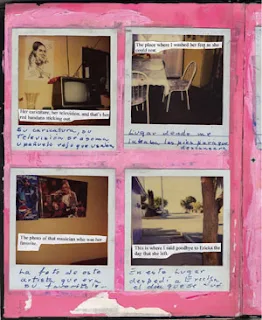Article by Rick Klaw
Celebrity philanthropic efforts often center around a few photo opportunities showcased to further a career. These usually well-meaning events generally turn a fleeting spotlight on the truly needy, such as the numerous Africa plights, conquered Tibet
Kirshner visited four ravaged areas, conducting interviews with the women and children most affected.I Live Here compiles her encounters in Ingushetia , Burma , Ciudad Juárez, and Malawi
The Russian republic of Ingushetia lies on the border of Chechnya 50 miles from the embattled country’s capital, Grozny, more than 15,000 Chechen refugees currently live in Nazran, Ingushetia, primarily in tents and abandoned buildings. Kirshner first encounters the orphaned 12-year-old boy Ruslan at the edge of a dirt lot. Through an interpreter, Ruslan relates stories about his father’s missile-ravaged body and the killing of his mother by a drunk driver. Kirshner then meets Ruslan’s foster mother, Yakha, who fled her home for a different reason:
“Yakha remembers the day. It was February 26, 2001, and her husband was drunk, as always. Eighty thousand Russian troops were in Chechnya , and they had been in control of Grozny
Yakha eventually returned to Grozny
In perhaps the most disturbing volume, Kirshner meets with several Thai sex workers and young Burmese soldiers, ages 13 and under. Graphic stories of rape, abortion, and hunger emerge from the desperate women that work in Mae Sot along the Thai-Burma border. The prostitutes, often conscripted in their pre-teens, powerfully relate the inherent cruelty and desperation of their situation. As in all of the volumes, photographs and pictures by and of the oppressed appear with the words — none as effective as the intense images of the barbaric abortion methods. No pro-life fetuses here, just the starkness of a gloved hand entering an anonymous vagina and a drawing of a “homemade abortion stick.”
This book also contains Karen Connelly’s “The Princess of the Sagawa Tea Shop.” The best fiction in I Live Here, it emotionally shares the trials of an experienced Thai prostitute who wants to retire and raise a family.
The impoverished, international drug-trafficking center Ciudad Juárez, across the Rio Grande from El Paso
While complete with images from Ericka’s life, the interview pales next to Margret Atwood protegé (and Mia sibling) Lauren Kirshner’s “Twenty Poems for Claudia,” a creative non-fiction essay recounting the life of another victim. The story begins with a FedEx box:
“In the box there are photos of gray highways and underpasses. Pictures of you wearing white powder and blue contact lenses, with your mouth closed like you you’ve got a secret you want to tell. There’s an interview with your mother, who says God will take care of everything. There is a photo of the Lear factory where you worked making electrical harnesses for American cars. There’s a photo of a pariah street dog with an empty potato-chip bag on its mouth, one yellow eye visible and disappointed. There are pages from your high-school notebook: a few notes about John Locke, the Enlightenment, knowledge for all. The notes stop halfway down the page, where fat graffiti takes over.”
Lauren Kirshner accomplishes far more than rehashing Claudia’s short life — she experiences it, complete with confusion and disgust over this unsolved murder and the countless others.
The massive weight of the AIDS crisis crushes Malawi
In the same volume, Kirshner visits the Kacher Prison for boys. The inmates, all between 11-19, are are often locked up for petty offenses for years at a time. No one claims them, not because of harsh penalties but rather the epidemic. Kirshner intertwines the story with the young men’s own words.
The magnificent design by Adbusters alumni Paul Shoebridge and Michael Simons weaves the disparate elements into one of the finest looking publications ever produced. In toto, the package forms an amazing work of art. An exceptional book of rare quality, I Live Here exceeds all expectations. •
©Rick Klaw
I Live Here
by Mia Kirshner, J.B. Mackinnon, Paul Shoebridge, Michael Simons
Pantheon
$29.95, 320 pages
by Mia Kirshner, J.B. Mackinnon, Paul Shoebridge, Michael Simons
Pantheon
$29.95, 320 pages



